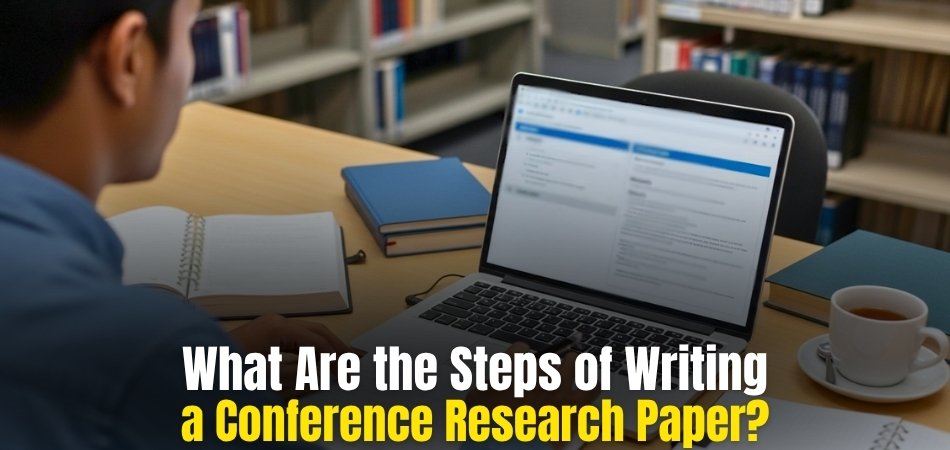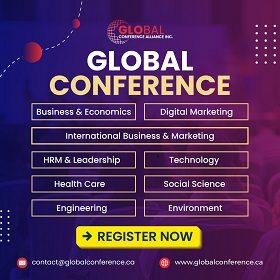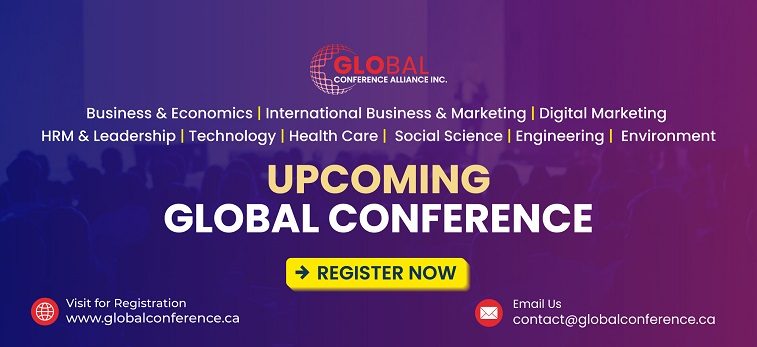Writing a conference research paper is a big step for anyone who wants to share their work with others. It takes time, effort, and a clear plan to turn an idea into something that’s ready to present. You might be thinking about where to begin or wondering what are the steps of writing a conference research paper?
To write a conference research paper, first choose a clear topic, review related work, and select the right conference. Then conduct your research, create an outline, and write using IMRaD format. Revise carefully, follow formatting rules, and submit before the deadline.
Do you want to know how to do each of these steps the right way? Keep reading this article—you’ll find everything you need to understand the full process and finish your conference paper with confidence.
What Are the Steps of Writing a Conference Research Paper?
Writing a conference research paper is a structured process that moves from a broad idea to a polished, formatted document. Here are the essential steps, broken down into distinct phases:
Phase 1: Pre-Writing and Planning
This is the foundational phase where you lay the groundwork for your paper. Skipping or rushing through this phase can lead to confusion and weak contributions later on.
Step 1: Develop Your Research Idea and Question
Before you write, you need a core idea. This should be:
- Novel: Your research should provide something new to the field—this might be a unique dataset, a new analytical method, a theoretical insight, a technical improvement, or a synthesis of existing knowledge with a new lens. Ask yourself: What is new in what I’m proposing?
- Relevant: The problem you are addressing should be of genuine interest to your target audience. Read recent papers from top conferences in your area to understand what kinds of topics are actively discussed.
- Feasible: Your research plan must be achievable with your current resources (time, data, computational power, expertise). It’s better to narrow your scope than to propose something too ambitious for your timeframe.
Refine your idea into a clear and focused research question or hypothesis. This will guide every decision you make—from what literature to include to what results to emphasize.
Step 2: Conduct a Thorough Literature Review
You cannot contribute to a conversation without knowing what has already been said.
- Explore Existing Work: Use trusted academic databases such as:
- Google Scholar
- IEEE Xplore
- ACM Digital Library
- ScienceDirect
- SpringerLink
- Scopus
Focus on papers published in the last 5–10 years, particularly in reputable conferences and journals.
- Identify the Gap: Determine where your work fits. Look for:
- Unanswered questions
- Conflicting findings
- Outdated techniques
- New contexts (e.g., applying a known method to a new domain)
- Build Your Foundation: Use these sources to:
- Justify your research question
- Support your arguments
- Define concepts
- Show how your work builds upon or deviates from previous efforts
Take detailed notes and organize your citations using a reference manager from the start.
Step 3: Select the Right Conference
This is a strategic decision that affects the impact and reception of your work. If you’re preparing for conferences, especially for international events like conferences in USA, Canada, UAE, or any other country where visibility and networking are key, selecting the right venue becomes even more critical.
- Scope and Topics: Read the Call for Papers (CFP) carefully. Ensure your topic fits the themes and goals of the conference. Some conferences have specialized tracks—choose the one that best fits your paper.
- Prestige and Audience:
-
- Consider tier-1 vs. tier-2 conferences.
- Look at acceptance rates (lower often means more competitive).
- Consider who reads and attends—academic researchers? Industry professionals? students?
-
- Deadlines:
-
- Submission deadlines are often months before the actual conference date.
- Track abstract deadlines, paper deadlines, notification dates, and camera-ready submission.
- Consider time zones (a submission due at 11:59 PM GMT is not the same as 11:59 PM PST!).
-
- Formatting and Page Limits:
-
- Most conferences provide LaTeX/Word templates—download and use these early.
- Page limits often include references, so plan accordingly.
- Check if supplementary material is allowed (e.g., code, data, appendices).
-
Step 4: Conduct Your Research and Gather Results
This is the core of your project. Whether you are proving a theorem, running an experiment, analyzing a dataset, or building a system, you must be meticulous.
- Methodology: Define a clear, rigorous methodology that others can understand and potentially replicate.
- Data Collection: Collect your data or perform your experiments.
- Analysis: Analyze your results. What did you find? Use statistical methods or other analytical tools appropriate for your field.
Step 5: Create a Detailed Outline
Before you start writing sentences, structure your paper logically.
Use the IMRaD format (common in scientific writing):
- Introduction: What’s the problem? Why does it matter?
- Methods: What did you do, and how?
- Results: What did you find?
- Discussion: What does it mean?
For each section, outline bullet points or short phrases. This will make the actual writing much smoother.
Phase 2: The Writing Process
This is where you translate your research and outline into a cohesive, formal document.
Step 6: Write the First Draft
The goal here is to get your ideas onto the page. Don’t worry about perfect prose. Many researchers find it easiest to write the sections out of order:
- Methods and Results: Start here. These sections are descriptive—you are simply stating what you did and what you found.
- Introduction and Discussion/Conclusion: Write these last. It’s much easier to introduce and conclude your work once you’ve fully written down the core details.
- Abstract: Write this very last. It’s a summary of the entire completed paper.
Use active voice where possible and avoid jargon unless your audience expects it.
Step 7: Flesh Out Each Section
Each part of your paper should now take shape with clear, focused content, with the following academic standards.
- Title: Make it descriptive and catchy. It should accurately reflect your work.
- Abstract: A concise summary (typically 150-250 words) covering the problem, your method, key results, and the main conclusion.
- Introduction: Hook the reader, provide context (briefly), state the problem and its importance, clearly state your contribution and research question, and provide a roadmap for the rest of the paper.
- Related Work (or Literature Review): Position your work within the field. Explain how it differs from, or builds upon, previous research. This can be a subsection of the Introduction or its own section.
- Methodology: Detail exactly what you did. This section must contain enough information for another researcher to replicate your work. Describe your setup, dataset, algorithms, or analytical procedures.
- Results: Present your findings objectively, without interpretation. Use figures, tables, and graphs to present data clearly. Each figure and table should have a caption and be referenced in the text.
- Discussion: Interpret your results. What do they mean? How do they answer your research question? Compare your findings to those in the related work. Acknowledge the limitations of your study.
- Conclusion: Summarize your key findings and their implications. Reiterate your main contribution. Suggest promising avenues for future work. Do not introduce new information here.
- References: List all the sources you cited. Use a reference manager like Zotero, Mendeley, or BibTeX (for LaTeX) to keep this organized and consistently formatted.
- Appendices (Optional): Include supplementary material that is not essential to understanding the main paper, such as detailed proofs or extra data.
Step 8: Revise, Edit, and Get Feedback
This step turns a good draft into a great paper.
- Revise for Clarity and Logic: Read your paper aloud. Does the argument flow logically? Is the language clear and unambiguous?
- Edit for Conciseness: Academic writing should be concise. Remove redundant words and sentences. Ensure you are within the page limit.
- Proofread for Errors: Check for typos, grammatical mistakes, and formatting errors.
- Get Feedback: This is crucial. Share your draft with your advisor, colleagues, or a writing group. A fresh set of eyes will catch mistakes and logical gaps you missed.
Be open to criticism—each revision brings you closer to a polished result.
Phase 3: Submission and Review
This final phase is about delivering your work to the community and receiving feedback from experts.
Step 9: Final Formatting
Before submitting, make sure to:
- Use the official conference template.
- Follow line spacing, font, margin, and figure placement rules.
- Double-check page limits (some conferences have strict limits, including references).
- Embed fonts and ensure figures are high-resolution.
- Check for anonymity if the review process is double-blind.
Step 10: Submit the Paper
- Upload your paper to the conference’s submission system.
- Fill out metadata: title, abstract, author info (if allowed), keywords, conflicts of interest.
- Double-check that the correct version was uploaded.
- Make sure all co-authors approve the submission.
Step 11: Wait for Peer Review
After submission:
- Your paper is assigned to 2–4 expert reviewers.
- You may receive feedback such as:
- Accept: Your paper is accepted with minimal or no changes.
- Minor/Major Revision: Revise and resubmit based on reviewer comments.
- Reject: Common and not the end. Use the feedback to improve and resubmit elsewhere.
Treat reviewer comments as valuable advice—even when they’re critical. Responding respectfully and thoroughly improves your work and your reputation.
By following these steps, you can navigate the complex process of writing and publishing a conference research paper effectively, producing work that contributes meaningfully to your field.
How to Choose the Right Topic for a Conference Research Paper?
Choosing the right topic for a conference research paper can feel tricky at first. There are so many ideas out there, and picking just one might seem confusing. But don’t worry—there’s a simple way to figure it out. Keep reading to learn how to choose a topic that fits well and stands out.
Match the Theme
Start by checking what the conference is mainly about. Every conference has a theme or subject area it focuses on. Your topic should connect well with this. If the conference is about science, don’t choose something about history. Pick something that clearly fits into what they are looking for. This gives your paper a better chance of being accepted.
Pick What Interests You
Go with a topic you actually enjoy. If you choose something boring to you, working on it will feel like a chore. But if it’s something you like or find cool, it becomes fun to learn and write about it. It also helps you stay excited from beginning to end, which makes your paper better.
Make It Unique
Try not to pick something that’s already been done too much. Look for a fresh angle or a question people haven’t answered yet. This makes your paper stand out and keeps readers interested. Even if it’s a common subject, add your own new twist or a different way of looking at it.
Check What’s Possible
Before deciding on your topic, think about what you can actually research. Do you have enough information and time to work on it? Make sure your topic is not too hard or too easy. It should be something you can explain well and give clear points about in your paper.
Ask for Feedback
Once you have a topic in mind, it’s okay to ask someone else what they think. A fresh opinion can help you see if your topic makes sense or if it needs a little change. Others might give ideas to make your topic even better or help you avoid mistakes early on.
Picking the right topic takes a little thought, but it’s not hard when you break it down step by step. A good topic should match the theme, be something you like, and offer a fresh idea. Make sure it’s something you can research easily and explain clearly. With the right topic, writing your paper becomes a lot more fun and meaningful.
What Is the Ideal Structure of a Conference Research Paper?
Understanding how to structure a conference research paper can really help you write clearly and share your ideas better. There’s a simple format that most papers follow, and each part has its own job. Let’s go over each one together.
Start with Abstract
The abstract is like a short summary at the beginning of the paper. It gives a quick idea of what your research is about. You don’t need to go into detail here—just say what the topic is, what you did, and what you found. Keep it short and clear. People read this first to decide if they want to read the whole paper.
Write the Introduction
An introduction tells what your topic is and why it matters. Here, you can explain a bit of background and what problem you are trying to solve. You should also mention your main idea or goal. This section helps the reader understand what to expect. Keep it interesting so they want to keep reading more.
Explain the Method
This part is where you explain what steps you took to do your research. Say how you found your information or how you tested things. Be clear but simple. The goal is to let others know how you did it so they can follow or try it too. Don’t add too much detail—just the important steps.
Share the Results
Now it’s time to show what you found out. This part is about facts and data. You can write what happened during your research or what your test showed. If you have charts or tables, you can use them too. Try not to give your opinion here—just share the results clearly.
Wrap with Conclusion
The conclusion brings everything together. You talk about what your results mean and how they answer the question you started with. If there were any problems or things you could not finish, you can say that too. You might also give ideas for what can be done next. Keep it short but strong.
Each part of a conference paper has a clear role and helps your writing stay neat and easy to understand. If you follow this simple structure, your paper will look well-organized. It also makes it easier for others to read your work. Just take it one part at a time, and you’ll do great.
Tips to Write a Strong Abstract for a Conference Research Paper
Writing an abstract might feel like a small task, but it plays a big role in your research paper. It’s the first thing people read, and it helps them decide whether to keep reading or not. That’s why your abstract needs to be clear, short, and strong. Keep reading to learn some simple tips that can help you write a great one.
- Keep it short: Write only the most important things. Try not to add extra details that aren’t really needed in the beginning.
- Make it clear: Use simple words and make sure each sentence is easy to understand. Avoid using confusing or long sentences.
- Say the purpose: Let the reader know what your research is about and why you did it in just one or two clear lines.
- Mention the method: Talk about how you did your research or study. Keep it simple and only share the main steps.
- Share the result: Write about what you found or learned from your work. Just give the main point, not every little detail.
- Show the value: Explain why your research is useful or important. Help the reader understand how it can help or be used.
- Don’t add extras: Avoid adding quotes, detailed data, or examples. Save all that for the main paper, not the abstract.
- Stay honest: Only write what you actually did and found. Don’t add anything you didn’t study or prove in your paper.
- Use the right tone: Keep it serious and focused. It should sound smart but still simple and not too full of big words.
- Read and check: Always read your abstract a few times and fix any mistakes. Make sure it says exactly what your paper is about.
Writing a good abstract is all about keeping things simple but strong. It should say a lot in just a few lines. If your abstract is clear, more people will want to read your full paper. So take your time and make it count.
How to Align Your Research Paper with Conference Guidelines?
Not every research paper can be sent the same way to every conference. Each event has its own rules about how papers should look and what they should include. Missing these details can get your paper rejected. Keep reading to learn how to match your work with what the conference wants.
Follow the Format
Every conference gives clear instructions on how the paper should be written. These may include font style, size, spacing, and even margin size. If you don’t follow these, your paper might look messy or unprofessional. Organizers expect you to stick to their format so all papers look the same. Always download the format guide and read it carefully before starting your paper.
Stick to Word Limits
Word limits are not just suggestions—they are strict rules. Your paper should not be too short or go beyond the limit. If it’s too long, the organizers may not even read it. Try to keep your writing simple and focused. Cut out extra words that don’t add value. A well-edited paper is easier to read and shows that you respect the rules.
Use Their Template
Most conferences provide a ready-to-use template to help you. This template shows exactly where to place titles, headings, and other sections. It’s like a guide that helps you build your paper the right way. If you don’t use the template, your paper may look different from others, which can cause problems. So always start your work inside the given template.
Check All Requirements
Some conferences ask for extra things like keywords, charts, or special sections. You might also need to add a cover page or declaration form. Be sure to check whether the conference requires you to write a conference paper proposal before submitting your full manuscript—many events use this step to screen ideas. It’s small details like these that can make a big difference.
Review Before Sending
Once you’ve finished writing, go back and double-check everything. Read the rules again and see if your paper fits all of them. Look at the format, word count, and file type. Make sure nothing is missing. A final check can help you avoid small mistakes that could lead to rejection. Taking a few minutes here can save a lot of trouble later.
Following conference guidelines might seem boring, but it’s very important. It shows that you’re serious and respectful of the rules. Even small mistakes can cost you a chance to be accepted. So take your time and do it right.
What Do Reviewers Look for in Conference Research Paper Submissions?
When you send your paper to a conference, it doesn’t get accepted right away. A group of reviewers reads it carefully and decides if it should be included. They look for certain things before saying yes. Let’s take a look at what really matters.
Fresh New Idea
Reviewers want to see something new that hasn’t been said too many times before. Even if the topic is common, your way of looking at it should feel different. It could be a new question, a new method, or a new answer. A fresh idea makes the paper more exciting and more likely to get noticed.
Easy to Understand
A paper that’s hard to read will lose attention fast. Reviewers like it when things are said clearly and simply. If they don’t understand what you mean, they won’t spend time trying to figure it out. Good writing, short sentences, and simple words make your message stand out better.
Fits the Topic
The paper should match what the conference is about. If the event is about science, and your paper is about music, it won’t fit. Reviewers check if your work fits the main theme. Make sure your topic is linked to what the conference wants, or it may get rejected quickly.
Good Use of Data
If your paper has results, the data should be correct and make sense. Reviewers like it when the results are shown clearly, maybe with a table or chart. They also want to see how the data supports your main point. Just guessing or saying random things won’t help your paper.
Has Some Impact
Reviewers think about what your paper adds to the topic. Does it solve a problem? Does it make people think in a new way? Even small ideas can be useful if they are clear and helpful. A paper that has some value will always catch their attention more.
Knowing what reviewers care about can really help when writing a research paper. It’s not about using big words or fancy charts. Just stay clear, stay relevant, and bring something new to the table. That’s what really makes a paper shine.
Common Mistakes to Avoid When Writing a Conference Research Paper
Writing a conference research paper can be challenging, and even experienced researchers sometimes make mistakes that reduce its quality and impact. Avoiding these common pitfalls is key to improving your chances of acceptance and clearly presenting your work. Here are some mistakes to watch out for:
Poor Organization and Structure:
-
- Lack of a Clear Narrative: The paper doesn’t tell a coherent story. There’s no logical flow from the introduction to the conclusion, making it difficult for the reader to follow your line of reasoning.
- Disjointed Sections: Sections don’t transition smoothly, or information feels arbitrarily placed.
- Inconsistent Formatting: Failing to adhere to the conference’s specific formatting guidelines for headings, citations, figures, and tables can make the paper appear unprofessional and difficult to read.
- Missing or Misplaced Essential Sections: Forgetting to include key sections like a clear methodology, related work, or a thorough discussion of results, or placing them in an illogical order.
Lack of Focus and Clarity:
-
- Vague Problem Statement: The research problem is not clearly defined or its significance isn’t adequately explained. Readers are left wondering what specific issue the paper addresses.
- Overly Broad Scope: Trying to cover too much in one paper. Conference papers typically have strict page limits, so a narrow and well-defined focus is essential.
- Unclear Contribution: The paper doesn’t explicitly state its novel contribution to the field. What new insights, methods, or results does it offer?
- Ambiguous Language and Jargon: Using imprecise language, overly complex sentences, or unexplained technical jargon can alienate readers and obscure your message.
Weak Arguments and Insufficient Evidence:
-
- Unsupported Claims: Making assertions without providing sufficient evidence, data, or logical reasoning to back them up.
- Flawed Methodology: The research design is not robust, or the methods used are inappropriate for the research question. This can lead to unreliable or invalid results.
- Inadequate Data Presentation: Presenting data without proper context, labels, or explanations makes it difficult for readers to interpret.
- Insufficient Discussion of Results: Merely presenting results without adequately interpreting their meaning, implications, or limitations.
- Ignoring Negative Results: Only reporting successful outcomes and omitting negative or inconclusive results, which can be just as important for advancing knowledge.
Failing to Address Related Work:
-
- Limited Literature Review: Not conducting a comprehensive review of existing literature, leading to a lack of understanding of the current state-of-the-art.
- Insufficient Comparison with Prior Work: Not clearly articulating how your work differs from, builds upon, or improves upon previous research.
- Plagiarism (Intentional or Unintentional): Failing to properly cite sources or presenting others’ ideas or words as your own. This is a serious academic offense.
- Misrepresenting Related Work: Incorrectly summarizing or critiquing existing research, which can demonstrate a lack of understanding of the field.
Neglecting Presentation and Review:
-
- Poor Abstract: A weak or uninformative abstract fails to capture the essence of the paper and its contributions, discouraging reviewers from reading further.
- Typos, Grammatical Errors, and Spelling Mistakes: These errors make the paper appear unprofessional and can distract from the content.
- Ignoring Reviewer Feedback (for revisions): If submitting a revised version, failing to adequately address the comments and suggestions from previous reviewers.
- Last-Minute Submission: Rushing the writing and submission process often leads to oversights and errors that could have been caught with more time for review and revision.
By being mindful of these common mistakes and dedicating sufficient time to planning, writing, and meticulously reviewing your conference research paper, you can significantly enhance its quality and increase its chances of being accepted and making a meaningful impact.
How to Properly Cite Sources in a Conference Research Paper?
Citing sources in a conference research paper is very important. It shows where your information came from and gives credit to the right people. Using the correct style also makes your paper look clean and professional. If you don’t cite properly, it can seem like you’re copying, even if you didn’t mean to. Let’s take a look at the main citation styles and how they’re used.
| Style Name | Used In | In-Text Citation | Reference Format Example |
| IEEE | Engineering, Technology | [1], [2] | [1] J. Smith, Book Title, Publisher, Year. |
| APA | Psychology, Social Sciences | (Smith, 2020) | Smith, J. (2020). Book Title. Publisher. |
| ACM | Computer Science | [1] or (Smith 2020) | [1] Smith, J. 2020. Book Title. Publisher. |
| MLA | Literature, Humanities | (Smith 20) | Smith, John. Book Title. Publisher, 2020. |
| Chicago | History, Arts | (Smith 2020) or footnotes | Smith, John. Book Title. City: Publisher, 2020. |
Citing sources the right way helps you avoid copying someone else’s work. It also lets others find and read the sources you used. Each field uses its own style, so check the conference rules before choosing one. And always give credit where it’s due—it’s just the right thing to do.
What to Do After Your Conference Research Paper Is Accepted?
Getting your paper accepted by a conference is a big moment to celebrate. But that’s not the end—there are a few more things to take care of. These steps are important to make your work fully complete and ready. Read below to know what to do after your paper is accepted.
Final paper format
You’ll be asked to send a final version that follows certain rules. This version must match the format the conference organizers shared earlier. Look for things like correct font size, spacing, and file type. If anything is missing or wrong, your paper might not be accepted again. Make sure all names, emails, and titles are correct. Carefully check your paper for spelling or grammar errors. Once done, save it and upload it on time.
Register early
Most conferences won’t include your paper unless you finish registration first. Look out for the registration deadline so you don’t miss your chance. Early registration usually costs less than late registration or on-the-spot booking. Make sure you choose the right type of ticket while registering online. If you need travel or stay plans, start preparing them early too. Once everything is done, save a copy of your confirmation. This step is quick but very important.
Share your work
Letting others know about your paper can be helpful and exciting too. Some people post short messages on websites or email their friends. Others prefer to tell people in person or at school. After acceptance, many researchers choose to submit conference paper to ResearchGate to increase visibility and share their findings with a broader academic audience. Doing this can help others read and learn from your paper. Sharing your work makes it more useful and fun.
Get your slides ready
It’s always a good idea to make your slides clear and simple. Use bullet points and pictures instead of long text blocks everywhere. Try to fit your talk within the time you’re given. Practicing in front of others can help you feel more confident. Speak slowly, and don’t try to read every word. Focus on the main points people should remember. A good presentation helps others understand your paper better.
Attend the event
Joining the conference is a nice way to enjoy your hard work. You get to see what other people have been working on as well. Listening to talks can help you learn new things easily. Don’t be shy to ask questions or meet people during breaks. Even small talks with others can be interesting and fun. If it’s online, check your internet and join on time. Just showing up makes you part of something big.
Getting your paper accepted is something to be really proud of. But following the next steps helps your work feel more complete. These steps are simple but matter a lot in the end. So finish them all and enjoy the whole experience fully.
FAQs About What Are the Steps of Writing a Conference Research Paper?
If you’re writing a conference research paper for the first time, it’s normal to have lots of questions. From how to begin to what happens after writing, there are many small things that matter. These FAQs will help you understand the process better and avoid mistakes. Let’s look at some common questions that students often ask.
What Is the Best Way to Start Writing a Research Paper?
The best way to start is by planning your idea clearly. Think about what you want to write and why it matters. Then write down your main question and list a few points that you will explain. Making a small plan helps you feel less confused and more focused.
How Can I Make My Research Paper More Interesting?
To make your paper more interesting, try to explain your ideas with real examples or simple comparisons. Use easy language that other students can understand. You can also add small pictures or charts if they help show your point better. A fun fact or surprising result in your research can also grab attention.
Why Is It Important to Have a Clear Research Question?
A clear research question helps you stay on track. It tells you what to look for and what to write about. Without a clear question, your paper may go off-topic and confuse the reader. It also helps others quickly understand what your paper is trying to solve.
Can I Use Internet Sources in My Research Paper?
Yes, you can use internet sources, but they must be trustworthy. Choose websites that are from schools, colleges, or well-known science and news sites. Don’t use blogs or random pages because they may not be correct. Always mention where you got the information from.
How Do I Know If My Paper Is Easy to Understand?
After writing, read your paper out loud. If you feel confused or if the sentences sound too long, change them. You can also ask a friend or teacher to read it and tell you if it’s clear. If they understand it easily, then your paper is written well.
What Is the Role of Headings and Subheadings?
Headings and subheadings make your paper neat and easy to read. They show where one part ends and the next part begins. Readers can quickly find the information they want by looking at the headings. It also helps you organize your ideas better.
Is It Okay to Include My Own Opinion in the Paper?
Yes, but only if you explain it with proof. You must give reasons, facts, or examples to support your opinion. A research paper is not just about saying what you think—it’s about showing why you think that way. Your opinion should help answer your main research question.
How Much Time Should I Spend on Each Step?
Try to give enough time to every step. Spend a few days planning and researching, then take more time writing and editing. Don’t try to do everything in one day—it can make your work messy. A little time every day is better than rushing at the end.
What Should I Do If I Get Stuck While Writing?
If you get stuck, take a short break or talk to someone about your topic. Sometimes saying it out loud can help you think better. You can also go back to your outline to see what’s next. Don’t be afraid to change your plan if a better idea comes.
Conclusion
Writing a strong paper takes more than just good ideas—it needs careful planning and clear steps. From choosing a topic to submitting the final version, each phase plays a big role. If you were wondering what are the steps of writing a conference research paper, now you know they include planning, researching, writing, editing, and submitting.
To end on a helpful note, always keep your paper well-organized, follow the conference rules, and give yourself enough time to revise. Stay focused, keep things simple, and don’t be afraid to ask for feedback. You’ve got this—best of luck with your research paper!










